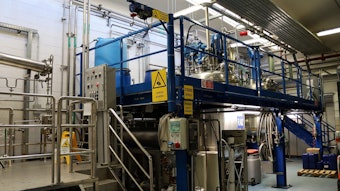Improved automation, simplicity and “smart functions” are among the capabilities and attributes of today’s filling equipment, allowing manufacturers to achieve more with less and marketers to distinguish themselves through the development and use of unique packaging.
You’ve contracted a lab, they’ve formulated a winning product, and you’ve sourced eye-popping bottles and tubes. You’re ready for production. How are you set for filling equipment?
Liquid filling equipment can be a sizable investment—whether for a start-up with modest production runs, a company managing global brands or filling contractors—and basic considerations include size, speed, accuracy, changeover/cleaning time, no-container/no-fill system, drive location and equipment standards.
According to The Wiley Encyclopedia of Packaging Terminology, liquid filling machines can be classified in terms of two fundamental characteristics: the employed filling method and the container positioning method—from manually loaded to in-line and rotary fillers. Methods of fill are divided into two primary categories, the sealed-container system and the unsealed-container system. Gravity filling is a simple and reliable method, and one that is typical of smaller production lines. In this system, product flows through a valve into the container and air from the container exits the bottle through the same valve.1
But what about today’s technology offers more than just the very basic? Industry experts explain the capabilities of today’s machines and the levels of innovation, customization and features that have improved speed to market. They also describe the benefits afforded by today’s filling machines.
Today’s Needs With an Eye on Tomorrow
Increased and improved automation capabilities, versatility, speed and “smart functions” are being engineered into filling machines, and the engineering itself considers more aspects of the filling process—these machines do more than simply fill. Capabilities include the handling of a variety of products and packaging, control systems and automated CIP (clean-in-place) systems to ensure sanitary filling conditions.
“The most improved capability seen on filling machines today is the versatility of the machine to handle a wide variety of products,” said Dennis Bertolucci, senior industrial designer/sales, Simplex Filler Company, a liquid filling machine manufacturer. “This is mainly due to the fantastic improvements in programmable electronic controls and sensors that are available today at competitive costs. Companies today provide more products through ‘just in time’ delivery. This means smaller batches and packaging with more variety of products running through the same machine.”
According to Bertolucci, today’s liquid filling machines handle different products and containers with quicker changeover, less set up time and better repeatable accuracy. With improved versatility, a wide variety of products and packaging can be handled with a minimal outlay in capital cost. Further facilitating the drive toward versatility, effective machines today have to be designed with modularity and an array of plug-in accessories.
“Business owners that can do more variety in products and packaging with fewer pieces of equipment, and a smaller staff, will benefit in stability and value, in a competitive market place in an ever-changing economical climate,” said Bertolucci.
Surefil LLC, which provides custom filling solutions to the personal care and medical industries, has recently added three high-speed packaging lines—an additional 85 million units of capacity to the 40 million units previously running. The company saw the expansion as an opportunity to install state-of-the-art filling equipment with smart functions—among them, vision systems that ensure fill levels, CIP systems programmable with a set of procedures that follow, in sequence, opening valves, calling for cleaning and sanitizing chemicals, and providing water at high temperature to clean the equipment—without requiring disassembly.
Cleanability and ease of changeover remain high on customer requirements when purchasing new liquid and tube filling equipment, according to John Erdner, director of the liquid and cosmetic division for IMA North America.
“As cosmetic companies continue to expand and diversify their product lines to meet consumer demands, the ease in being able to package a wide range of products and container sizes becomes crucial,” said Erdner. “Liquid fillers such as the IMA Libra Flexifill F940 use an interchangeable filling assembly or carriage, that can be removed from the filler when changing products or flavors and swapped out with another carriage.
This creates more uptime for the customer as the entire section is removable and can be cleaned off-line, leaving the machine still in production to fill another product.” The design changes in liquid fillers that have been made over the past few years have focused on making the machines easier to clean and change over between products, as well as simply being made faster. Some lines of tube fillers, for example, offer machines that can fill and seal or crimp both plastic and metal tubes on the same frame.
“These filling machines are also designed to make it easy to access every part of the machine, from every angle, to simplify the cleaning process and to facilitate changing components when introducing a different product or tube size,” said Lee Villeneuve, marketing director and liquid product manager for IMA Nova, which handles sales and service for the CO.MA.DI.S. product line, which Villeneuve cites as an example of a tube filling line that offers the multiple functions noted above.
“Present day filling machinery offers advancements in electronics and further use of pneumatics,” said Drake Chocholek, vice president and CIO, Accutek Packaging Equipment Companies. “This makes our filling machines more affordable, easier to operate, virtually maintenance free and much easier to clean. Gone are the days of the big mechanical beasts with gears, cranks and pulleys. Companies that are purchasing these new machines are gaining benefits from having to do less maintenance. We have continuously worked on improving and simplifying our designs to make it easier for the end user to operate, maintain and clean.”
Other capabilities such as the ability to weigh each bottle to ensure proper fill weights have benefits beyond controlling costs—it ensures that label claims are met and in compliance with regulatory organizations. Furthermore, vision systems are capable of orienting custom caps on bottles, and servo driven motors allow each capper head to function independently, depending on the package requirement. This allows marketers to develop more unique packaging while maintaining a line that is manufacturable at high speed (up to 300 bottles per minute) and, therefore, low cost.
By working closely with filling equipment manufacturers, custom solutions can be found for unique marketing propositions—found in either the packaging or the product itself. “For the major cosmetic companies with large production requirements, one trend [in customization requests] we’ve seen is an increased use of servo drives in general” said Erdner. “Servo drives provide the capability and advantage of changing filling parameters per product.”
Surefil cites compounding of specialized formulas and filling into new and unique packages as a crux for custom solutions, and faces filling more than 120 distinct SKUs in custom packaging—a trend that is not likely to abate as marketers look for points of differentiation. Accutek notes that almost all of its machines ship with some form of customization to suit the customer’s requirements.
“Packages and labels will continue to evolve. Labels will continue to be different sizes and shapes, as will the bottles and caps. This continuous stimulation is required by the marketing companies so they can stimulate the consumers to buy,” said Bill Hunt, CEO, Surefil. “New bottles will, at the same time, need to be made with reduced costs. This means lighter weight bottles, more unstable shapes and unique caps. Contractors will have to make big dollar investments in servo driven rotary labelers, servo driven cappers, high precision fillers and vision system to bring it all together. With high-speed operations, the contractors will also have to make big investments in controls to make it all work together. This means integrating lines with Ethernet capability to allow all machines in a given line to talk to each other.”
“Customers’ business practices are changing and evolving,” said Bertolucci. “Customers are increasingly fitting into tighter spaces to accomplish the same amount of work output that was done in larger spaces just a few years ago. This philosophy of doing more with less overhead is becoming a common business practice. With this philosophy, customers are packaging more of a variety of products in smaller batch runs to accomplish just in time delivery with fewer pieces of machinery, so they do not have to maintain large on-hand inventories.”
Designing a Filling Line
To achieve more with less, companies require more compact, versatile machinery that will handle a variety of products while maintaining ease of operation. According to Bertolucci, today’s machinery has allowed small businesses with limited employees, mechanical expertise and resources to play a vital role in the industry and become competitive manufacturers.
“The large corporation with a highly staffed, experienced maintenance/service department is a thing of the past,” said Bertolucci. “More companies today are smaller upstarts where the budget is tight, manpower is limited, and the employees all wear many hats. The traditional operator or maintenance departments are not the norm for small businesses today. Most small companies are owner-operators, which means the owner is a chef or a chemist and does not necessarily have a technical background or department as his predecessor of the past. Today’s machinery needs to be simpler and more intuitive to operate because of the lack of on-hand mechanical support.”
“While there is always some trial and error, the design always begins with the final product,” said Hunt. “You must ask, ‘What do you want to make?’ Then we have to answer, ‘How many do you need to make? What about a growth factor?’ Then we look at how much space is required and what level of automation is needed. It is then critical to bring the right resources together to get it all done.”
Erdner notes that there has been a recent shift among high-end cosmetic manufacturers toward styles of operation that align their processes more closely to the pharmaceutical world. From a machinery perspective, this means building equipment to FDA standards and ensuring that machines are efficient and flexible for evolving marketplaces. At the same time, fillers need to remain versatile, compact, easy to operate, easy and quick to clean, adaptable to ever-changing products and containers with minimal cost, and, above all, reliable, with a high return on investment.
“Cost and quality will continue to remain key focus areas for marketing companies,” said Hunt. “Additionally, the focus on hygienic manufacturing will increase. This will require suppliers to have the best possible water systems, USP 29, very effective CIP systems for compounding tanks, hold tanks, process piping and the fillers. This is the basic equipment side.”
“Simplex is constantly striving to achieve these [standards],” says Bertolucci. “The business model today has changed from the departmentalized corporations to highly efficient small business teams. Work handled by three people in the past is now handled by one person. The machinery fills in for the reduced manpower. This opens the door for a new generation of entrepreneurs in a highly competitive world market. Individuals expressing their view of a better mousetrap will open up a future of unlimited possibilities. Using machinery as the tool [it was] meant to be and freeing up more people to use their creativity will only improve our future. What is difficult is keeping rising costs of materials in check. Customers do not see the associated rising costs of materials and the general loss of technically proficient fabricators and technical personnel. These are the difficult challenges facing us in the future.”
References
1. FB Fairbanks, “Filling Machinery, Liquid, Still.” The Wiley Encyclopedia of Packaging Terminology (Second Edition), John Wiley & Sons, Inc., New York, 290–297 (1997)










